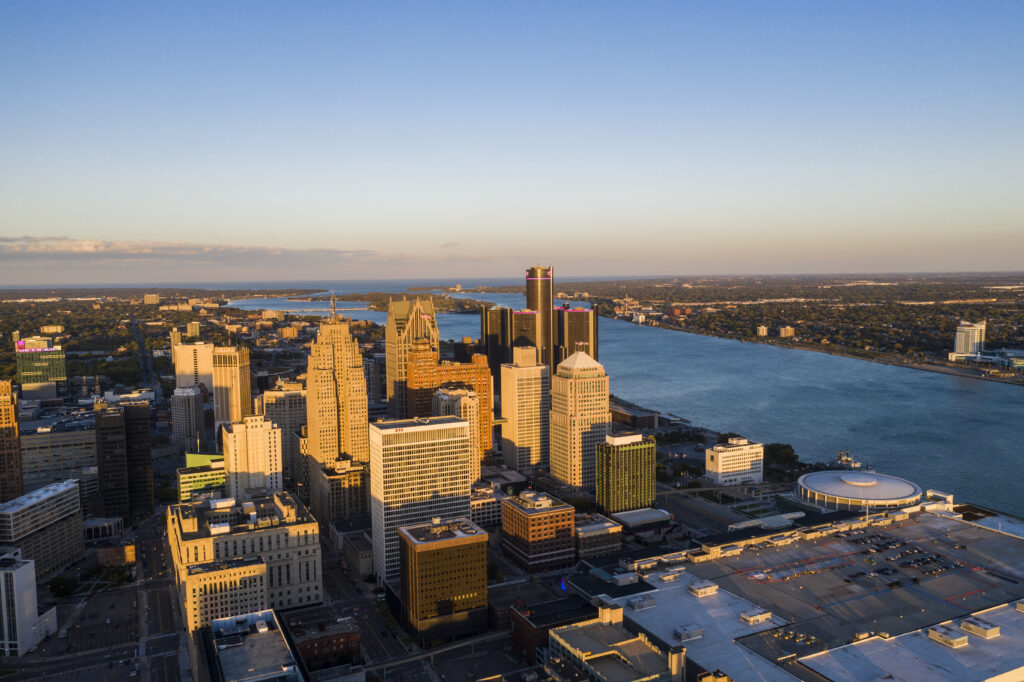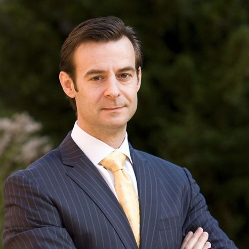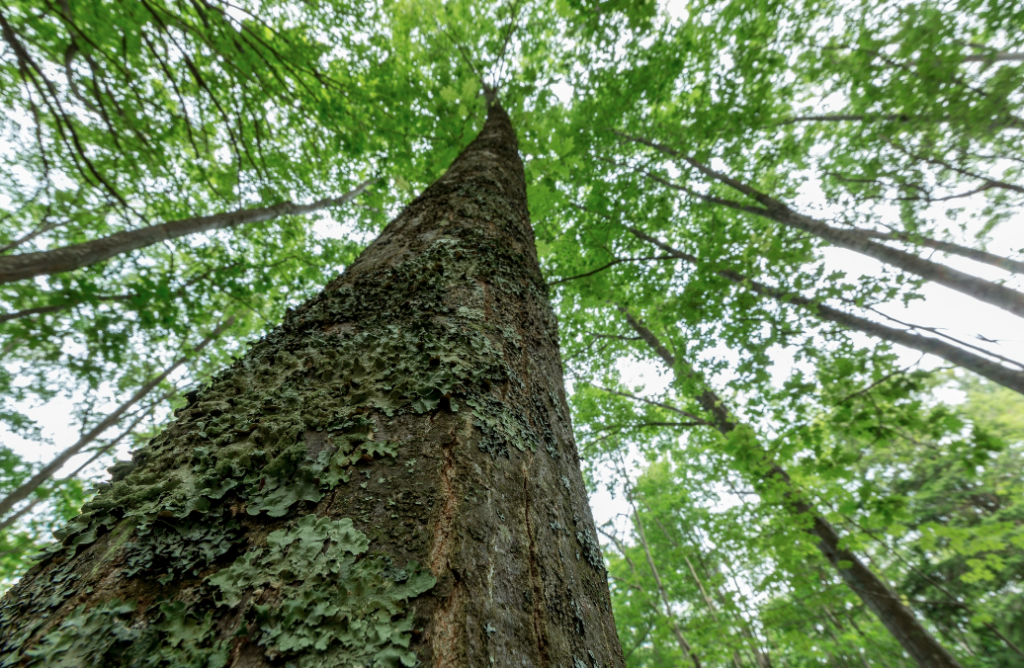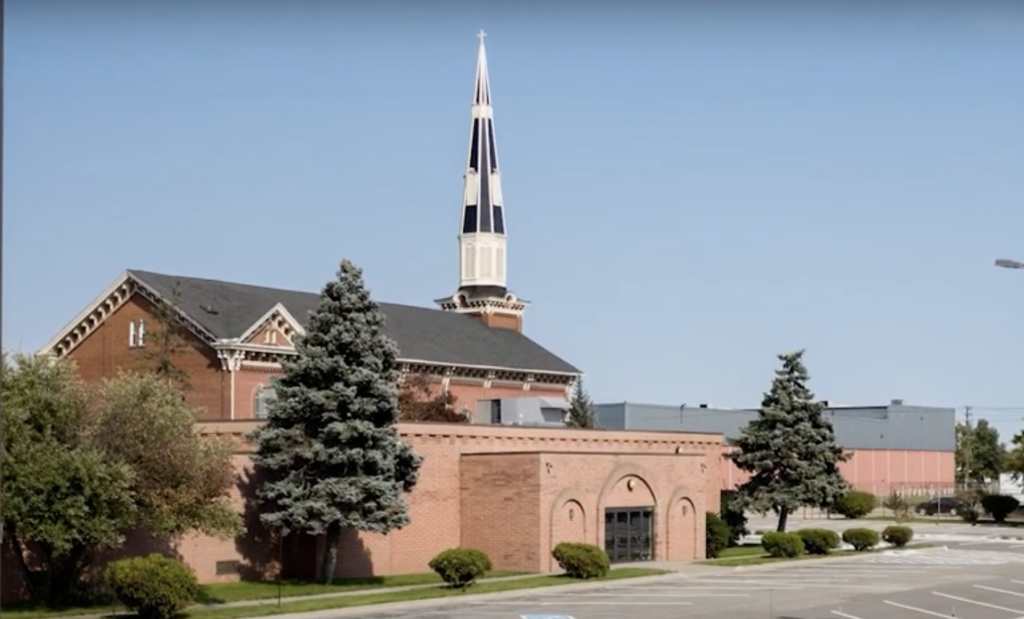Tackling Water Infrastructure and Coastal Challenges in Michigan

Ann Arbor-based CIS was founded in 2013 by Corvias, a Rhode Island-based company that provides infrastructure services to the military, state and local governments, and higher education. In 2023, it was spun off as an independent company whose services center on solving the complicated challenges of outdated and ineffective stormwater infrastructure. SBN Detroit interviewed the company’s CEO, Sanjiv K. Sinha, Ph.D., and Sri Vedachalam, Ph.D., Senior Director of Water Equity and Climate Resilience, about two recent projects – an advisory and research project focused on coastal conservation for The Nature Conservancy, a global conservation nonprofit, and an analysis of Great Lakes Regional Poll (GLRP) data for a binational federal agency. Q: What were the primary goals of the coastal conservation analysis services you provided for The Nature Conservancy? Vedachalam: The main goal of this project was to conduct a comprehensive scoping exercise to identify and understand the key challenges faced by Great Lakes communities in relation to fluctuating water levels, high-energy waves, and climate-induced shoreline erosion. Shoreline erosion in particular is becoming increasingly prevalent due to climate change, and our focus was to assess how these environmental stressors impact both the natural and built environments. By gaining a clearer understanding of these challenges, our goal is to help surrounding communities become more resilient. This involves preparing infrastructure to withstand the ongoing and future effects of these changes. Q: What are the key environmental challenges currently affecting coastal areas in Southeast Michigan and the broader Great Lakes region? Vedachalam: Coastal areas in the Great Lakes region face a variety of interconnected challenges, mainly involving three key components: the lake itself, the shoreline, and the watershed. Rising and fluctuating water levels, coupled with stronger energy waves, contribute to significant shoreline erosion. These forces can disturb lakebed sediments, which, in turn, impact aquatic organisms and their habitats. In addition, increased rainfall—often intense and unpredictable—introduces higher levels of pollutants and contaminants into the lakes, further exacerbating environmental stress. The watershed is also heavily affected by these factors, particularly in terms of increased flooding, which places additional strain on both natural ecosystems and human infrastructure. Addressing these challenges requires a multifaceted approach that combines both natural and engineered infrastructure to mitigate damage and enhance community resilience. Sinha: To add some context, climate change is causing regions around the Great Lakes to experience more rainfall in shorter periods of time, leading to severe issues such as flooding and water quality challenges such as algal bloom in western Lake Erie. The frequency and intensity of these rain events are increasing, which complicates regional water management. As an example of changed rainfall, based on 1992 estimates, a hundred-year storm in Detroit used to be 4.4 inches of rainfall, while in 2019, a similar storm produced 5.2 inches—an additional two billion gallons of water. According to SEMCOG, by 2050, storms of this nature could result in 7.7 inches of rainfall, adding another six billion gallons of water. Preparing communities and infrastructure for such occurrences is essential as we look toward the future. And these massive challenges present an incredible opportunity for the region to grow its economy by deploying capital that leads to local jobs. Q: Based on this project, what specific actions or solutions is CIS proposing to protect Great Lakes coastal communities? Vedachalam: It will take a balanced approach that integrates both hard infrastructure and nature-based solutions to address the complex challenges these coastal communities face. One focus is wetlands, which historically covered vast areas across the Great Lakes region. Over time, urbanization has led to the loss of many of these wetlands, reducing their ability to naturally manage stormwater. So, we need to design infrastructure to help slow down stormwater runoff before it reenters the lakes. Additionally, we need to stabilize dunes and other natural barriers, which play a critical role in protecting the shoreline from erosion and the impacts of fluctuating water levels. These natural elements act as a first line of defense, mitigating the force of incoming water while preserving ecosystems. Another critical area of focus is people. It’s crucial to involve residents in these efforts to ensure that the solutions we propose are compatible with how people live and interact with these spaces. Through collaborative efforts with the community, we can foster a sense of ownership and ensure that the projects we implement meet both environmental and societal needs. Q: What unique opportunities or risks does Southeast Michigan face regarding water management and coastal resilience compared to other areas of the Great Lakes? Vedachalam: Southeast Michigan presents a unique mix of challenges. Historically, this region was rich in biodiversity, with vast expanses of marshes and wetlands serving as natural buffers against flooding and erosion. However, as the area became more urbanized and industrialized, many of these natural systems were altered or lost. Despite this, there remains a kind of “ecosystem memory,” where there is potential to restore these natural practices and processes in some areas. One of the main challenges the region faces is balancing the needs of a highly industrialized and sprawling urban environment with the goal of restoring natural systems. Legacy pollution from past industrial activities continues to pose a risk. There is growing interest from communities to return to more sustainable, nature-based solutions. Q: To this end, what is the importance of polling data in understanding public sentiment on Great Lakes water issues? Vedachalam: Polling data is critical because it allows us to measure public sentiment at a specific point in time and over time. Public sentiment can be dynamic, especially following significant events, much like we see in political polling. Attitudes often shift slowly over time, so conducting annual polls helps track these changes and offers insights into how public perceptions and concerns evolve. Sinha: The Great Lakes represent a highly complex system, involving eight U.S. states and two Canadian provinces. This vast geographic area makes it essential to carefully assess how public sentiment varies across the region. Polling helps identify which stakeholders hold specific concerns and how
How the UN Summits on Climate Change and Biodiversity Affect Our World

Global leaders met in Egypt in November 2022 to attend the COP27 Summit on Climate Change and again in December in Montreal for the COP15 Biodiversity Conference, reaching significant agreements to drive important changes around the globe. How are the outcomes of those meetings affecting the world, the business community, and our lives in Michigan? SBN Detroit hosted Andrew Deutz, director of global policy, institutions, and conservation finance for The Nature Conservancy, in a virtual event on May 4 to share his insights. Deutz – an expert in international environmental law, policy, and diplomacy – directs the TNC’s global policy work spanning the areas of biodiversity, sustainable development, and conservation finance and oversees relationships with international organizations, multilateral development banks, and foreign aid agencies. During this event, he addressed why these global meetings are relevant to our everyday world; what impacts we should anticipate in our decision-making as business leaders; and how The Nature Conservancy is participating in these global discussions to assure a sustainable world for both people and nature. Moderator Tammi Dukes, Adient’s vice president of global sustainability, facilitated a Q&A session that followed. Deutz set the stage by explaining that there is a deep Interrelatedness between climate change, biodiversity, and the global economy, and, essentially, we cannot fix one without the others. This global theme is driving the discussions and outcomes of these meetings that will in turn help inform the way businesses make and target goals, secure supply chain partners, develop sustainability practices, allocate budgets, and more. In terms of biodiversity and climate change, there are tipping points in ecological systems as the climate warms. For example, in Southeast Asia, if we increase to two degrees Celsius we will start to lose coral reefs. If the Amazon River warms three to four degrees, the rainforest could shift to grassland. In the Arctic, we could lose permanent sea ice. All of these have repercussions on the integrity of the ecosystem and economy, and they also facilitate additional warming that exacerbates the trends. The Montreal Biodiversity Conference informed us that more than half of the global economy is dependent on nature, and if we continue to degrade nature it will undermine the economic world as a whole. The world currently spends $140 billion on preservation, yet also spends four to five times that amount undermining it through harmful subsidies. To become nature-positive, it is estimated that $700 billion-$900 billion is needed annually. Deutz said to reverse the trends, we need to make changes in the global economy. So, the question becomes, how do we address the climate crisis and nature preservation with the growing debt crisis? How do countries allocate funds toward these goals? Deutz gave examples of countries forgiving debts in exchange for allocating funds toward forest preservation, the government buying back financial debt and replacing it with funds to spend toward climate resilience, and other alternative options that are coming out of the leadership discussions. Deutz also noted that businesses are becoming continually more aligned with the UN’s 2030 Sustainable Development Agenda, so progress is being made. In addition to global environmental goals such as the 2030 Agenda and the 2050 Environmental Goals, there also are tangible frameworks for companies to understand and assess climate risk so that they can measure and reduce impact; practices on how to drive decarbonization; and incentives for companies to invest in greener companies and more. Following is the Q&A that took place after Deutz’s presentation. Dukes: Do you think manufacturers in the U.S. are operating at a rate that will get us to the goal of carbon neutrality by 2030? Deutz: No. But nobody is. We are making progress, but we have to accelerate that progress. There are two drivers, I think. First, investors need to back companies that are aligned with the 2030 Agenda. Second, we need to start seeing this happen through corporate supply chains as well. For example, in the UK and Europe, there are now trade provisions that restrict the import of commodities that drive deforestation. Companies need to be responsible for their supply chains and ensure that all parts of the chain are driving toward net zero goals. Dukes: What is the buy-in of countries so far and what traction has been made? Deutz: It’s a mixed bag, but we’re seeing a lot of progress. Most of the major economic players at the government level have set targets toward 2050 or 2060. Those targets still aren’t good enough, but most of the world is on a pathway. On the nature side, it’s a little more complicated. There is a coalition of 130 countries that came together before Montreal and agreed to the 30×30 initiative, which refers to ensuring good conservation practices around 30% of terrestrial and marine habitats by 2030. There seems to be an easier consensus around that than how we sustainably manage the other 70%. Ultimately, sustainability is about 100% of the landscape being sustainable. We have a lot further to go on figuring out how to manage the 70%. Dukes: What are the key indicators in nature that we need to pay attention to? Deutz: There are two key indicators. The first is vegetation cover. As the world loses vegetation coverage, it impacts water balance, and science is showing less rainfall is falling on land. As I said earlier, there is a risk of the Amazon transitioning from rainforest to grassland. Less vegetation results in less water in the atmosphere and we begin losing agricultural potential, which could turn into a global food crisis. The second is species extinction. We are losing species at a rate of ten to 100 times faster than the rate of natural extinction, and these animals help maintain the ecosystem. Dukes: What role can small businesses play in achieving change? Deutz: The answer is the same as large businesses. Assess your supply chains and put the same practices into place. But yes, large businesses are being called on to meet certain criteria first, because they can,
The Nature Conservancy of Michigan – Working at the Intersection of Economic Development, Nature, and Sustainability

The Nature Conservancy in Michigan recently released its 2022 Michigan Conservation Results Report that outlines the work it is doing to tackle conservation issues that range from climate change to biodiversity loss. With 32,000 members, a staff of 55+, 25 trustees, and many contributors, partnerships, and donators, 32,541 acres of land became protected last year, totaling 437,000 acres to date. We spoke to Associate State Director Patrick Doran about some of the key initiatives outlined in the report. Q: A recent acquisition of land in the Keweenaw Peninsula nearly doubled the peninsula’s protected lands, which provide habitat for many iconic species. How does this impact the state and Southeast Michigan? A: It’s a great question – how the work we are doing in Northern Michigan impacts the entire state and beyond – and I want to give some context around that. TNC is the world’s largest conservation organization with almost 6,000 employees around the world. When we have a project in place, we think not only about executing that project with boots on the ground but also think about how it impacts the entire system. We lift our heads and assess the impact on the region, the Great Lakes, the state, and the world. We think about how it will affect the economy, the air, the climate, people’s quality of life, and more. Securing the 30,000-plus acres in Keweenaw is amazing for us. I also want to note that there are several partners and entities involved in these efforts. TNC could never have done this alone. The opportunity to move land into conservation at this scope just does not exist in too many places in the US. The land has been under traditional timber ownership and management. We see TNC as a temporary holder – maybe three to five years – and eventually, we’d like to see the land secured by the state and local townships and municipalities and counties. We believe local ownership achieves the best conservation outcomes. So, we will ensure it’s protected, and that the forest is under a sustainability management plan, so that the conservation status improves from what it was, all the while making sure that it remains available for public use and recreation. This project truly sits at the intersection of economic development, nature, and sustainability, and there are several ways that it connects to other parts of the system. Relating this to the Southeast Michigan area, ecologically, in the spring Keweenaw is one of the most important migration areas in the Midwest. Millions of hawks, songbirds, and more move from South America, hit the Great Lakes to the Detroit corridor up to the U.P., and the majority fly up the Keweenaw Peninsula before making the daunting trip across Lake Superior. Southeast Michigan is an important stop in their migration process. So, there is this interesting species connection between the Lower Peninsula and the U.P. The connection also ties into the economy and also climate change. Those forests are places where we can store carbon through the growth and management of trees and also keep the industry intact. It’s a careful balance. Sequestering carbon will help meet climate change goals and this impacts the whole state. We have robust timber and water industries throughout the state and in Southeast Michigan, and that’s very important to our economy. Another connection this project represents is with businesses across the state. TNC is exploring the most effective ways to work with companies across the state in their quest to meet their sustainability goals. The forests can support these companies in this quest, and the companies are in turn investing in the forests. TNC also has a partnership with the Michigan Manufacturers Association. The goal is to help educate and assist small and medium-sized businesses with sustainability planning. We offer a suite of workshops for these manufacturers and companies. Two good examples are Steelcase and Consumers Energy – we began working with both companies last year. Q: According to the report, all 47,000 acres of TNC’s forest reserves in Michigan are now FSC®-C008922 certified. What does this mean? A: What FSC certification does is up the level of sustainability management and make sure all are adhering to best practices in terms of how many trees are cut, frequency of cutting, how streams and lakes are impacted, etc. This makes the whole system healthier. Again, timber is a huge part of the state’s economy, and it’s important to manage this industry in a way that is thoughtful and promotes the ability to sequester carbon. The focus is to achieve our ecological goals and at the same time keep land in the timber industry. We are also involved in working with the manufacturing industry in Southeast Michigan and across the state to ensure they are actively using more sustainably produced timber. When the supply chain demands this, it becomes a more virtuous cycle. Relating this to the construction industry, there is also a movement in place to use cross-laminated timber or mass timber, which offers more long-term carbon storage in comparison to using cement or other building materials. The DNR and Michigan State University are working on reinvesting this back into the building and construction process. Q; Regarding our parks and waterways, the report references Public Act 53 of 2022, saying that ultimately $2.3 billion of the historic state funding included in the act was designated for the improvement of Michigan’s water infrastructure, with an additional $450 million for state and local parks. What is TNC’s role in these improvements? A: TNC operates at a policy and system level to impact our parks and water across the state. Michigan sits in the middle of one of the world’s largest freshwater systems, so we have to protect that. We work to promote healthy infrastructure and programs that support investing in that. Regarding the importance of maintaining our parks and nature within urban areas, I was at a conference last year in Detroit and began asking businesses why they think investing
Dan Carmody, Eastern Market Partnership CEO, Talks About Building Opportunity, Economy and a Stronger Regional Food System

Dan Carmody, Eastern Market Partnership CEO since 2007, spoke with SBN Detroit on the market’s positioning towards sustainable practices. Carmody is responsible for shepherding the 127-year-old, public market to nourish a healthier, wealthier, and happier Detroit. EMP operates one of the largest public markets in the United States, oversees a program of capital investments to rebuild the market, serves as the economic development organization to nurture and expand the Eastern Market District, manages a host of food access programs to improve Detroit diets, and builds an ecosystem to support Detroit food entrepreneurs. Carmody has led Eastern Market to become a national thought leader in developing new templates for how to repurpose urban vacant land and resurrect regional food systems. We talked to Carmody about EMP’s sustainability strategies. Q: Where do EMP’S strengths lie in terms of sustainability? A: Put quite simply, we work to help build a stronger regional food system to make us less reliant on large industrial food systems. There are not enough public markets in the U.S. that serve to support independent small businesses. Public markets are the original “pop up.” Small startups and entrepreneurs can pay the fee to rent a stall or tent and get moving on their business. We need more places like that around the country to help small businesses and not be so dependent on big companies. Q: What does sustainability mean to the market? A: It means that farmers are being compensated for crops in a fashion that allows financial success. It means farmers and growers embracing business practices that help us steward the earth in better ways than we are now. How do you approach partnering with sustainable companies in the food and agriculture industries? A: Two things I can point to that we work on are first, helping to make solar options more viable, and second, helping businesses work stormwater management into their practices to reduce the cost of operation and decrease the amount of stormwater run-off into the Detroit River. Q: How does the addition of these new entities move sustainability forward in Eastern Market? A: The new Mosaic food hall will be located at 3500 Riopelle St. in the former Detroit Water Department building. This building hasn’t been occupied since 1999, so the mere act of utilizing an existing building versus tearing it down and starting over is in itself a very significant sustainable practice. EW Grobbel, who’s been selling corned beef and other foods since the 1970s, will open a new grocery store and deli, creating 300 new jobs and offering local farmers a great venue to sell. These are two great examples of growth occurring now that help move sustainability forward. Q: Looking back eight to ten years, what was your selling point then to bring businesses into the market and also to approach sustainability with them? How has that changed? A: It has not changed much. We look for partners in the food sector and others that build the market as a regional food hub and also improve the business mix for the retail consumer supply and demand. There is an authenticity to the market that has always been there and is still today. Its focus is on independent businesses and if anything, we are becoming more vocal to make sure it remains this way as property values increase. Q What partnerships do you value when it comes to sustainability? A: One that comes to mind is our partnership with The Nature Conservancy in helping businesses design and implement stormwater management systems. This has been going on for several years. We piloted a conversion of a parking lot to retain stormwater at Sacred Heart Church in the Market District that resulted in the reduction of stormwater runoff and reduced their water bills greatly. Throughout our expansion, The Conservancy is helping us as we identify future buildout plans and repurpose urban land for industrial and commercial use to build in stormwater management systems as we go. Q: What can you tell us about the new expansion of the market? A: The expansion involves 25 to 30 acres and a $1 million food processing and distribution space. Again, this will bring new jobs to the Market District, more healthy food options for people in nearby neighborhoods, and vitality and growth to the whole district. Eastern Market has one of the largest footprints of any public market in the country – and we have the space and the means to go bigger. We’ve worked over time to bring in more value-added makers, and now the market is a viable market on Saturday all year and the expansion will strengthen that. From an economic standpoint, we work to offer more opportunities to entrepreneurs to help them grow, and we will continue to do so. We’ve received funding from the state to build what we are referring to as Shed X – a new wholesale distribution facility for regional farmers. Since 1891 farmers have come to the market between midnight and 6 am to sell to independent grocers. This has shrunk over the years and we are down to about 40 million pounds per year. This is not small, but it’s also not big in terms of food distribution. We hope to grow this by building a new, modern facility with refrigeration and docks that the farmers can more efficiently use. We’ll utilize solar lighting and stormwater management within this facility. All of this will serve to help the local economy, and the diversification creates and keeps jobs in the city. Be sure to subscribe to our newsletter for regular updates on sustainable business practices in and around Detroit.


